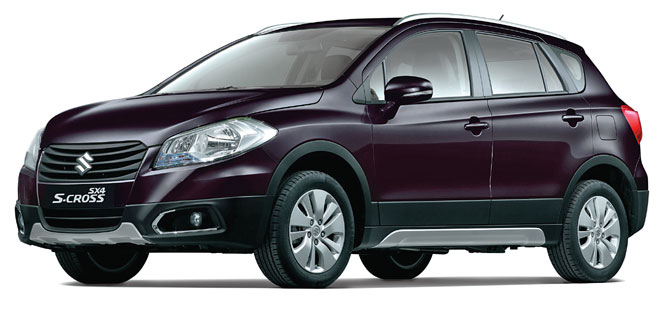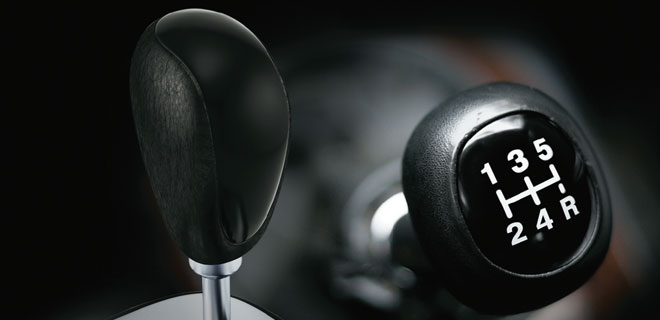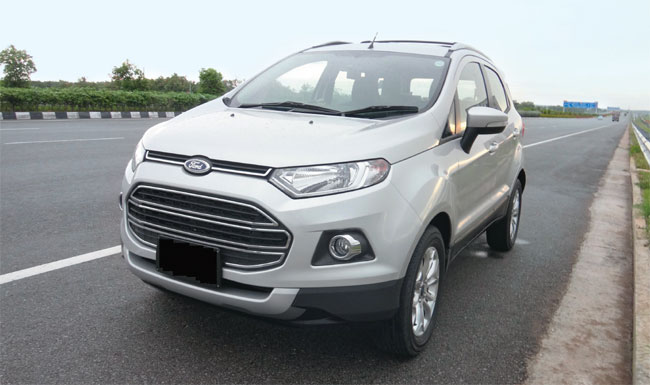Premium Shift
The S-Cross and Creta have been launched as entry-level luxury vehicles but are these really value-for-money?
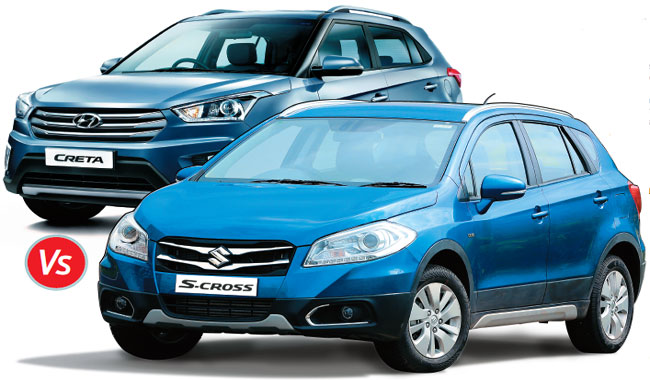

The one thing that you like immediately about the S-Cross is that it doesn’t pretend to be an SUV. And given the ‘compact SUV’ frenzy in the market right no; that’s no small matter. Manufacturers keen to join the party have introduced sedan variants with appropriately ‘muscular’ styling cues taken from bonafide SUVs. Now, Maruti has ruled the roost in the mass consumer market in India for too long to try a disingenuous stunt like that. The S-Cross is, and looks like, a really big hatchback.
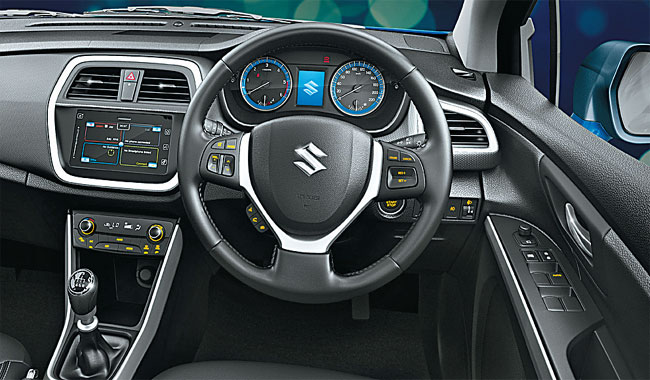
That said, it’s no head turner as looks go—alpha males in search of an aggressive-looking vehicle can stop reading just about now. But the big hatchback or ‘premium crossover’, as Maruti describes it, isn’t an eyesore either— plainly targeted at those looking for a practical premium vehicle and those who want to stay within the Maruti umbrella (there are upgrades for existing customers). Positioned somewhere between crossovers and SUVs, the S-Cross is almost as long as the Renault Duster, as wide as the Ford Eco Sport and taller than the Hyundai i20 Active, Fiat Avventura, VW Cross Polo and Toyota Etios Cross.
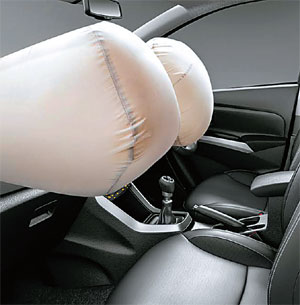 Get past appearances and the build quality is immediately apparent. Tipping the scales at 1,250 kg, the S-Cross is heavier than the Duster and feels solid in all aspects—doors close with a reassuring heavy thud and all fittings in the all-black theme-cabin are premium to the touch. The up market theme is really driven home with the leather seats and seven-inch touch-screen audio system (with USB, AUX and Bluetooth connectivity, plus navigation and voice commands). The Bi-Xenon projector headlamps are a first in this segment, as are the automatic rain-sensing wipers and lights. There is adequate head room and foot space in the front and rear—perfect for four people and accommodating of five.
Get past appearances and the build quality is immediately apparent. Tipping the scales at 1,250 kg, the S-Cross is heavier than the Duster and feels solid in all aspects—doors close with a reassuring heavy thud and all fittings in the all-black theme-cabin are premium to the touch. The up market theme is really driven home with the leather seats and seven-inch touch-screen audio system (with USB, AUX and Bluetooth connectivity, plus navigation and voice commands). The Bi-Xenon projector headlamps are a first in this segment, as are the automatic rain-sensing wipers and lights. There is adequate head room and foot space in the front and rear—perfect for four people and accommodating of five.
The S-Cross is only available in two diesel-powered options: DDiS 200 and DDiS 320. The 200 DDiS has a 1.3 litre motor (that also powers the Ciaz), while the 320 DDiS comes with a brand new 1.6 litre motor that’s imported from Italy. On the road, there’s no competition about which one we’d recommend: with 118 bhp and oodles of torque, the 1.6 litre S-Cross zooms ahead.
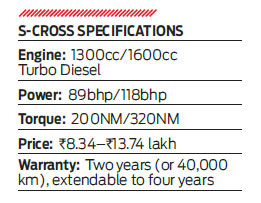
Besides, this is the best highway tourer from Maruti’s stable yet. In that sense, the S-Cross strikes a 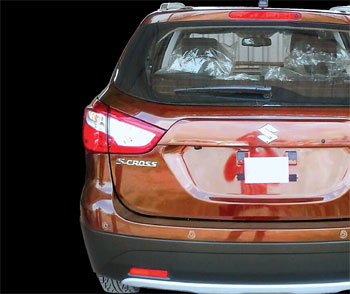 balance between its fun-to-drive and family-car credentials. Unfortunately, that performance is the preserve of the 1.6 litre, which doesn’t come cheap. Duties and taxes add up to a Rs.3 lakh premium over the 1.3 litre. Whether or not you feel that premium is justified will depend on what weightage you attach to performance. In terms of luxury, the 1.3 litre diesel is at par with the 1.6 litre and sold in all four variants—Sigma, Delta, Zeta and Alpha (the 1.6 litre is only available in the top three variants).
balance between its fun-to-drive and family-car credentials. Unfortunately, that performance is the preserve of the 1.6 litre, which doesn’t come cheap. Duties and taxes add up to a Rs.3 lakh premium over the 1.3 litre. Whether or not you feel that premium is justified will depend on what weightage you attach to performance. In terms of luxury, the 1.3 litre diesel is at par with the 1.6 litre and sold in all four variants—Sigma, Delta, Zeta and Alpha (the 1.6 litre is only available in the top three variants).
One look and you know that Hyundai has nailed it with the Creta’s styling. And if you’re instantly reminded of Hyundai’s flagship SUV—the Santa Fe—then you’re spot on, too. The Creta looks like a Santa Fe that’s been on a crash diet and with good reason too, you’d think. Cast in the mould of Hyundai’s new design language, this is a strikingly handsome car. So, it’s no ‘crossover’ then—the Creta looks exactly like the vehicle an aspirational would-be SUV owner is looking for. The 17-inch wheels on the top-end SX (O) version, which we drove, make a significant contribution to its road presence; in the event that you do buy a lower variant of the car, and then consider upgrading to these.
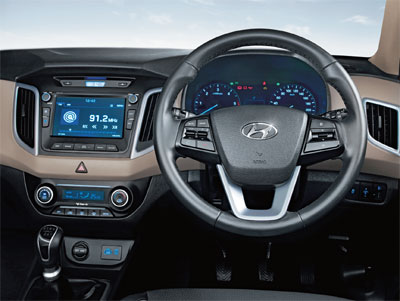
Behind the wheel, the driver’s orientation feels almost car-like. Cabin fit and finish are as top-notch as you’d expect in a Hyundai vehicle, in fact i20 Elite drivers will feel instantly at home in the Creta. There’s a prominent ICE touchscreen that headlines the dashboard and accommodates AUX, USB and Bluetooth audio inputs. Hyundai has ditched the CD player (thankfully) and the screen also displays navigation maps (MapMyIndia). As far as space goes, the reclining roof does make the rear feel a bit smaller than it is but there’s a surprisingly generous amount of legroom for both front and rear passengers.
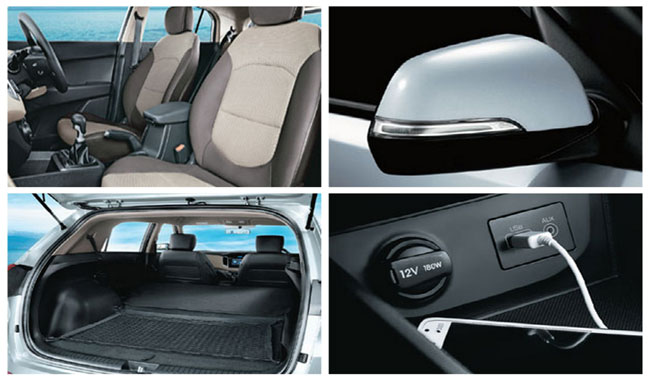
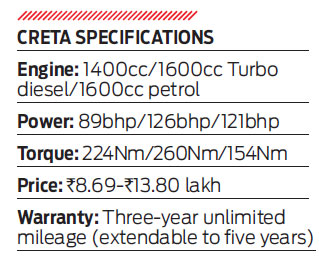 That said, by its own benchmark, Hyundai hasn’t done anything exceptional with the Creta’s interiors. The all-black theme is fine, and all fittings seem fairly premium, but not exceptional. You won’t be able to find fault with anything, just don’t expect to be ‘wowed’. There’s also some frugalness in terms of the kit considering that its the features that have differentiated Hyundai’s cars, specifically the i20. Unlike the S-Cross, there are no auto-headlamps or rain-sensing wipers. Even the auto-folding rear-view mirrors, steering reach adjustment or cooled glovebox, which you’ll find on the i20 Elite, haven’t made their way to the Creta. Why Hyundai has stuck with rear drum brakes—not even the SX (O) has four discs—is a bit inexplicable.
That said, by its own benchmark, Hyundai hasn’t done anything exceptional with the Creta’s interiors. The all-black theme is fine, and all fittings seem fairly premium, but not exceptional. You won’t be able to find fault with anything, just don’t expect to be ‘wowed’. There’s also some frugalness in terms of the kit considering that its the features that have differentiated Hyundai’s cars, specifically the i20. Unlike the S-Cross, there are no auto-headlamps or rain-sensing wipers. Even the auto-folding rear-view mirrors, steering reach adjustment or cooled glovebox, which you’ll find on the i20 Elite, haven’t made their way to the Creta. Why Hyundai has stuck with rear drum brakes—not even the SX (O) has four discs—is a bit inexplicable.
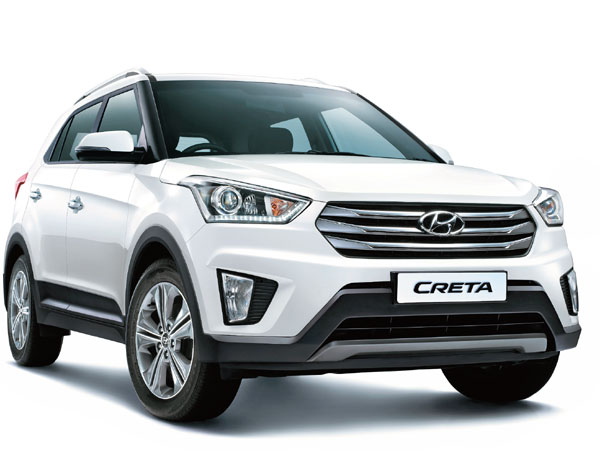
Under the hood, no complaints in the 1.6 litre diesel that we drove. Scores of Verna drivers swear by this engine which, in the Creta, puts out 126 horses—more than enough to propel the 1.3 tonne vehicle with adequate gusto. There’s also a 1.4 litre CRDI diesel option and a 1.6 litre petrol variant for those who’d rather stick to the cleaner fuel. Most crucially, the 1.6 litre diesel comes with an automatic option as well. For city slickers, that’s where the search ends. As it does, I suspect, for women drivers—the Creta is just slicker than its competitors, and that will definitely buttress its case to the ladies.
Bottom line
The Creta and S-Cross, whilst being in the same segment, are in fact targeted at consumers with different mindsets. The S-Cross is biased towards practicality while the Creta is just downright better looking. The S-Cross is loaded with features including ABS and two airbags, which are standard across all models. It also has disc brakes on all wheels unlike the Creta that has drum brakes on the rear wheels. The Creta also has ABS as standard but airbags are offered only from the S+ variants onwards. So, on safety parameters and if you’re considering the lower variants, the S-Cross is a better choice.
On the other hand, the Creta is available in petrol and automatic variants. The latter is a deal breaker for the S-Cross if you’re going to use the car for your daily commute. Also, Hyundai has a fantastic reputation for its after-sales service as well as reliability. The three-year unlimited mileage warranty sweetens the deal. None of these vehicles are offered in all-wheel-drive or 4x4 and aren’t likely to be much good off-road. If you want to go into the rough stuff, then look at the Mahindra XUV 500 or the Renault Duster.
The writer is Web Editor, Outlook Traveller, and pens automotive reviews for several publications


